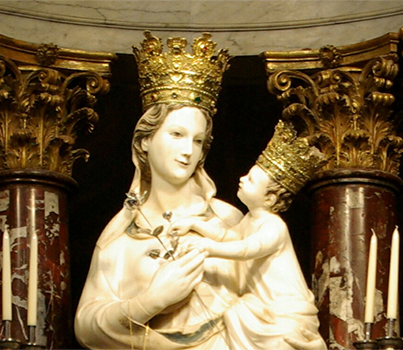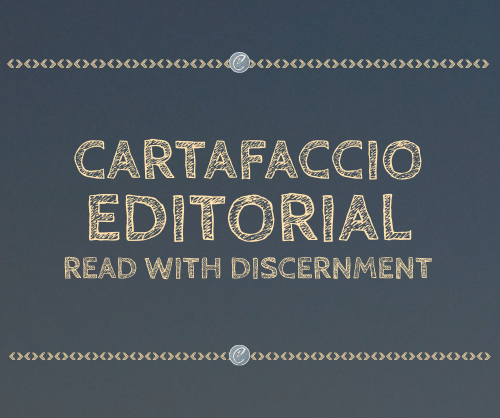Marian devotion in Sicily by Antonio Signorato
Original article was written in Italian: Feudum Mariae - rubrica mariana parte prima
English translation by L. Whitaker
‘Here and now, on the occasion of this congress, you are demonstrating that your loyalty to Christ and to the Church is solid and true, just as your devotion to the Virgin Mary is heartfelt, fervent and widespread. If anyone were to doubt this, you could show them a topographical drawing of the Island, and point out the splendid necklace of Marian shrines that touches each of its provinces, the mountains, the seas, the fertile plains, and makes Sicily a fiefdom of Mary’.
Thus spoke the Holy Father Pius XII in his radio message of 17 October 1954, addressing the Regional Marian Congress of Sicily. With these splendid words, the Holy Father gave Trinacria the most beautiful and flattering title that it is possible to give.
Feudum Mariae. A fiefdom of Mary.
The Immaculate Virgin, therefore, is Mother,
Sovereign, and Queen of this land. A land that undeniably has its troubles, but
is also full of riches, the most precious of which is undoubtedly its Marian
devotion.
This devotion, as the Supreme Pontiff describes, takes
a thousand different forms; as numerous as the many titles by which the Mother
of God is venerated and loved in every corner of her fiefdom.
It is beyond the scope of this page to give an account of each and every one of them, but nevertheless an attempt will be made in these articles to describe a few fragments of this splendid mosaic, so that the reader might garner an idea of the depth and width of the love of the Sicilian people for Holy Mary.
Given that we really will need to traverse Sicily’s
mountains, seas and fertile plains, the articles will be divided ‘geographically’, each one focusing on a specific area of Sicily.
In this first section, we will look at Western Sicily;
specifically, the province of Trapani.
Please humour me, therefore, as I begin by mentioning a Marian devotion that is particularly close to my heart: that of Our Lady of Trapani.
The Carmelite Sanctuary of the Annunziata, located in
Sicily’s western capital, is home to a marvellous marble statue of the Virgin
Mary with the Holy Child in her arms.
This sculpture, which nowadays is attributed to the artist Nino Pisano (14th century) but which tradition claims is much older, is admired for the Virgin’s expression: maternal and overflowing with sweetness, capable of giving comfort to all the devotees who have taken refuge under her mantle over the centuries.
The blessings and miracles obtained through the
intercession of Our Lady of Trapani are innumerable, and many of them are
memorialised within the Sanctuary itself.
Bishops and prelates, kings and sovereigns, have all
come to pay homage to her, as is demonstrated by the vast treasure trove of
votive offerings that once adorned the statue like a golden cloak, and which
are now kept in the adjacent Pepoli Museum.
The local seafarers have always been very devoted to
this sweet Madonnina, and in their wanderings over the centuries they have
spread her cult throughout the Mediterranean basin.
The apotheosis of this Marian devotion is A’ Quinnicina: the first two weeks in August, when all devotees of the beautiful
Madonna make a pilgrimage to the Sanctuary to honour the Mother of God in
preparation for the festival of the Assumption and the feast of the Madonna of
Trapani itself, which is celebrated on the following day, 16 August.
The pilgrims go to visit their Mother intoning ancient
prayers and songs in the Sicilian language, the most devout walking barefoot
and many setting off at the crack of dawn, especially if they are coming from
the surrounding countryside and cities.
There are also numerous testimonies of pilgrims
obtaining deliverance from demonic possession during this pilgrimage, through
the intercession of Our Lady of Trapani.
Another idiosyncrasy of this devotion is the fact that
the statue of the Blessed Virgin has been crowned twice: the first time being
on 14 March 1734 by decree of the Vatican Chapter, and the second time in 1934,
at the behest of Pope Pius XI.
There is no better summary of the beauty of the
sculpture and the importance of this devotion than that made by Gusman, Viceroy
of Sicily: upon admiring the sweet Madonnina, he said that anyone wishing to
see a more beautiful Madonna should go directly to Heaven!
We will now give an account of two other Marian
devotions that are connected with the Trapani area: those of the Madonna of
Custonaci and the Madonna of the Cava.
The Madonna of Custonaci is highly venerated
throughout the Erice area; so much so in fact, that she is the patron saint of
the towns of Erice and Custonaci.
This devotion is linked to a beautiful painting from
the late 15th or early 16th century, most likely by school of Antonello da
Messina, depicting the Virgin Mary suckling the Baby Jesus.
The icon arrived on the coast of Trapani - more
specifically, near the shore of a village that is nowadays known as Cornino -
following a miraculous event. The French ship that was carrying the painting
was caught in a terrible storm, but managed to escaped disaster by invoking the
Virgin Mary. In gratitude to the Blessed Virgin for helping them to find
shelter in the gulf, the sailors donated the Marian image to the local people,
who immediately moved it inland to defend it against pirate raids, and placed
it in the Chapel of the Immaculate Conception.
From the very beginning, the numerous miracles
obtained through the intercession of the Madonna of Custonaci helped to spread
this devotion; so much so that for many years, whenever the need arose for
divine help, the painting of the Madonna was carried in procession to invoke
her motherly intervention.
That was the tradition until 1936, when the work was
declared ‘immovable’ by the Sanctuary in order to prevent
it from becoming seriously damaged.
The patronal festivities last four days - from the
last Sunday to the last Wednesday of August - and are celebrated by all the
provinces where this splendid devotion can be found. The festivities are also
preceded by a novena and a pilgrimage on the Saturday morning, which departs
from Sperone and finishes at the Custonaci Sanctuary.
One of the most beautiful and meaningful moments in
the festivities is the re-enactment of the arrival of the sacred image on the
island and its journey to the Sanctuary, during which a blessing is given at
the Well of the Madonna, where, according to tradition, a spring of water
miraculously gushed forth.
The devotion of the Madonna della Cava, on the other
hand, is connected with the city of Marsala, where in the 16th century, a
deaf-mute Augustinian priest called Father Leonard Savina received several
visions of Our Lady, guiding him to a place where a sacred image of Her had
long ago been buried to save it from the destruction of iconoclastic heresy.
Our Lady called for an excavation to recover the image, and for a temple to be
built in her honour in the very same place. The people of Marsala immediately responded
with great enthusiasm, but the people's faith and devotion were sorely tested
by the long and fruitless excavation work.
After four years and several setbacks, only three
people remained in the search party: Father Safina and two other men: one lame
and the other blind. At long last, on 19th January 1518 the longed-for statue
was finally found! The icon is a small statuette just 18 centimetres high,
presumably made of Sicilian alabaster, depicting the Virgin Mary and the Child
holding a piece of bread, the symbol of the Body of Christ.
The first miracles came immediately: Father Safina
regained his voice and hearing, and his two companions could see and walk
again!
These were merely first of a long series of blessings
that the Madonna della Cava would bestow upon the city of Marsala and all of
its devotees.
The statuette was taken to the chapel attached to the
Augustinian monastery, but it miraculously returned to the place where it was
found, and continued to do so every time an attempt was made to move it, thus
demonstrating the Virgin’s wish for a new place of worship to be built in her
honour.
In the end, it was necessary to ‘give in’ to
Our Lady's wish, and the new church was built: first an underground temple, and
then a brick one above ground.
The Madonna della Cava, patron saint and protector of
the city of Marsala, has repeatedly saved the city from seismic events, and is
still commonly invoked today against natural disasters.
At this point, I must apologise to my discerning
readers for mentioning only three of Western Sicily’s many Marian devotions,
but our journey through the Fiefdom of Mary is only just beginning, and there
are many more tiles still to be added to this splendid mosaic!
Hail Mary!
Antonio Signorato
SOCIAL SHARE


